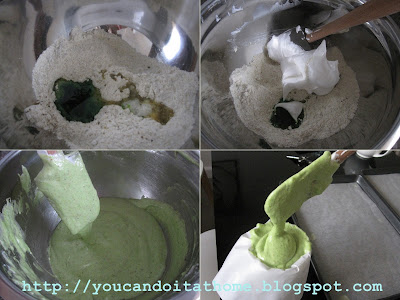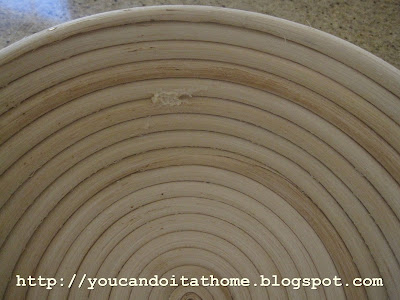I love Japanese green tea, be it a hot cup of green tea, green tea frappucino, green tea macaron, green tea ice cream, green tea cake, the list is endless and I love them all. I suppose its slight bitterness and unique aroma complement well with dessert.
During my trip to Japan late last year, I would try anything with green tea at any given opportunities. We had waffles filled with green tea mousse, green tea chiffon cake, green tea soft-serve ice cream, green tea tiramisu, choux pastry with green tea ice cream. I was in heaven!
 |
| Green tea tiramisu at the front and choux bun filled with green tea ice cream |
I stockpiled few different types of green tea powder (matcha powder) from my Japan trip (where else would be better place to get them, but Japan, right). All packagings were in Japanese so I wasn't exactly sure if I had bought matcha powder or something else. I had to go with the illustrations on the packagings instead and trust my instinct that I bought the right products. To find out, I need to test it with some of the bakings. Green tea bread with red bean is one of my favorite that I would test with the matcha powder. Green tea and red bean are something that are made for each other. The match made in heaven.
Japanese takes great care of their food presentation as much as the cooking itself. People eats with their eyes and it even more so with Japanese. Food looks as great as well as its taste. Follow this philosophy, the somewhat nice-looking green tea bread is on my mind.
 |
| Excellent looking food with excellent taste at Ryori Ryokan Hanaoka in Takayama, Japan where we stayed for two nights |
The bread style I was thinking about was decorative bread roll with incisions that show its filling. This style of roll is quite common in Asia or Asian bakery store in Australia. I took some of the rolls to my work and my workmate gave me a 10-out-of-10 for the appearance:)
I based the recipe on the sweet roll but tweaked the recipe by substituting 20% of bread flour with wholewheat flour, using sourdough starter to add more flavour to the bread and reduce the yeast amount in the recipe. However, if you don't have sourdough starter, you can substitute this with sponge (mixture of yeast, flour and milk mixed prior to the mixing of final dough). More details is in the below recipe.
This bread would make a great breakfast roll, in my opinion. It has green tea with cafreine to kick start the morning and fibre from wholemeal flour and red bean. It is also a yummy roll to start a delicious day.
Here is recipe...
Green Tea Bread Roll with Red Bean Filling Recipe
make approx 12 bread rolls
Ingredients
Sourdough starter 150 g (fed approx 12 hours the mixing)
Bread flour 460 g (increase this 535 g if you do not use sourdough starter)
Whole Wheat Flour 130 g (you can omit whole wheat and use all bread flour in the recipe)
Milk 210 g (3/4 cup) (increase this to 285 g if you do not use sourdough starter)
Egg 2 eggs
Salt 2 teaspoons
Butter 120 g, chopped
Sugar 60 g
Green tea powder (matcha powder) 1 tablespoon
Yeast 2 teaspoons (increase yeast to 1 tablespoon if you do not use sourdough starter)
Red bean paste (azuki bean paste) 150 - 200 g (store bought or make your own, recipe is here in my blog post)
Method
Mix starter, flours, milk, egg, sugar, green tea power, yeast and salt until all combined and form a dough ball. If mixing by hand, knead for about 10 -15 minutes until strong gluten is developed (the dough should pass a windowpane taste). If using a mixer, mix on a medium-high speed for 5 minutes until the dough pass windowpane test.
Note: if not using sourdough starter, mix 1 tablespoon of yeast, 10 g of sugar, 280 g of flour in the bowl. Pour in warm milk (285 g) and beat the mixture until smooth. Cover with plastic wrap and set aside for half and hour (the mixture should be really frothy and double in volume). Then, follow the step above.
Gradually incorporate butter into the dough while the mixer is running or kneading. The dough should be soft, silky and strong at this point.
Let the dough ferment in a bowl covered with plastic bag or cling wrap for about 1.5 to 2 hours until doubled in size.
Divide the dough into 12 portions, approx 100 g each and preshape them into balls and let them rest for 5 - 10 minutes.
Flatten the dough ball into round shape and put a heap tablespoon of red bean paste in the centre. Wrap and seal the dough to fully cover the red bean filling. Gently round the dough into ball (make sure the roll doesn't tear and red bean filling leak out).
Use a rolling pin, roll the dough gently (again, make sure the filling doesn't leak) into oblong shape about 0.50 cm thick.
Use a utility knife, making incisions on the shorter side of the dough (from left to right), and leave about half-a-cm on the edges, with 1-cm space between each cut. Be gently and precise when making incision, cut the dough to reveal the red bean filling, but do not cut the dough right to the bottom and it tears apart.
Using pastry scraper to help lifting the dough and turn it up side down, and at the same time, make sure that long side of the dough is now pararel to the kitchen bench.
Roll the dough like a jelly roll from top to bottom and seal the seam slightly. Gently bring two ends to meet in the middle. The roll should now resemble a donut ring without a hole or a tiny hole.
 |
| Excuse the poor lighting and shadow, the bake happened at night! |
Using pastry scraper to lift the roll and place on a baking tray lined with baking paper or baking sheet (you will need two trays for this recipe). Leave about 2-inch space between each roll as the dough will expand during the final proofing and during the bake.
Brush the rolls surface with egg wash and try to avoid brushing onto red bean filling as much as you can. Cover the trays with big plastic bags and leave at room temperature for approx 30 -45 minutes or until almost double in size.
Preheat the oven to 175c (convection oven).
When the rolls are ready, brush the dough surface again with eggwash before putting them into the oven.
Bake for 20 -25 minutes. Turn the tray half-way through baking for even browning.
 |
| Yummy breakfast |



























